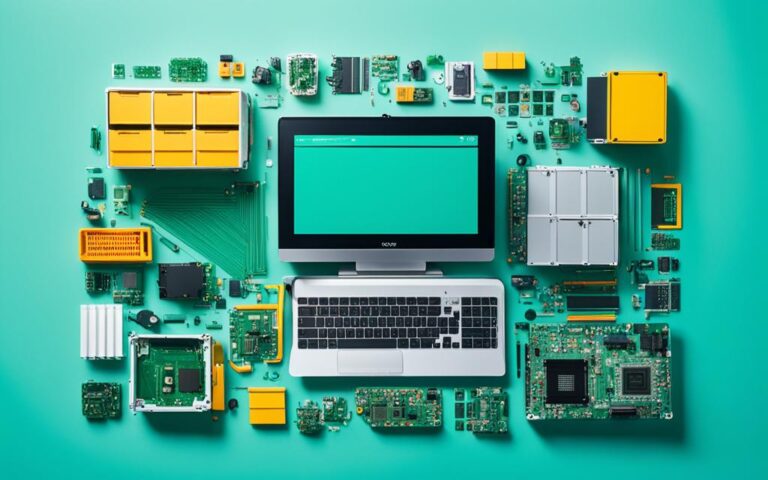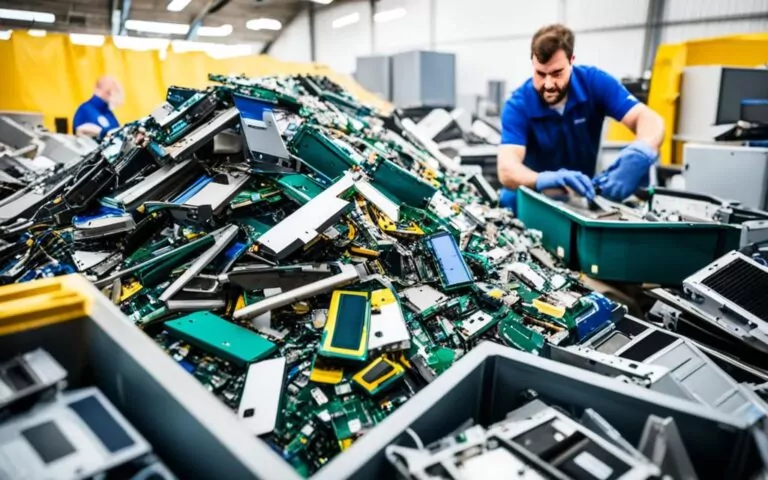Charting a Sustainable Course: Workstation Disposition
Sustainable workstation disposition is becoming increasingly important for businesses in the UK as they strive to embrace eco-friendly IT practices and reduce their carbon footprint. By properly disposing of workstations and implementing sustainable strategies, companies can contribute to a more environmentally conscious business landscape.
As the demand for technology continues to grow, so does the need for responsible and sustainable IT practices. From the manufacturing stage to the end of a product’s life cycle, every step in the process presents an opportunity for businesses to make a positive impact on the environment.
By focusing on sustainable workstation disposition, businesses can play a vital role in reducing electronic waste, conserving resources, and minimizing greenhouse gas emissions. This not only benefits the planet but also demonstrates a commitment to corporate social responsibility.
Implementing eco-friendly IT practices goes beyond simply recycling old equipment. It involves considering the entire life cycle of workstations, from their design and production to their eventual disposal. By prioritizing recyclability, energy efficiency, and the use of sustainable materials, businesses can contribute to a circular economy and reduce their environmental impact.
Furthermore, sustainable workstation disposition can also lead to cost savings and financial benefits for businesses. By adopting innovative ideas and streamlining resource use, companies can reduce waste, cut production costs, and improve overall efficiency. This not only contributes to environmental sustainability but also enhances the bottom line.
Ultimately, embracing sustainable workstation disposition is not just about being environmentally responsible; it is a strategic business decision. By prioritizing eco-friendly IT practices, businesses can reduce their carbon footprint, attract environmentally conscious customers and employees, and position themselves as leaders in their industry.
In the following sections of this article, we will delve deeper into the importance of sustainable workstation disposition, discuss steps to achieve safe and sustainable design, explore the financial benefits, and highlight the overall impact on sustainability in business.
The Importance of Sustainable Workstation Disposition
Designing safe and sustainable products is key to achieving a circular and low-carbon economy. Sustainable workstation disposition involves assessing product performance against requirements for safety and sustainability during the design phase, rather than after a product has been released. By focusing on chemical safety, recyclability, and reducing environmental impact, businesses can improve product safety, prevent pollution, and mitigate climate change.
To ensure chemical safety, businesses must carefully select materials that are free from hazardous substances and prioritize the use of sustainable alternatives. This not only protects the health and well-being of consumers but also minimizes the impact on the environment.
Recyclability is another crucial aspect of sustainable workstation disposition. By designing products with recyclable materials, businesses contribute to the circular economy by reducing waste and conserving valuable resources. This not only reduces the overall environmental impact but also opens up opportunities for recycling and repurposing at the end of a product’s life cycle.
Reducing environmental impact is a fundamental goal of sustainable product design. By employing energy-efficient manufacturing processes, using renewable resources, and minimizing waste generation, businesses can significantly mitigate their carbon footprint. This not only aligns with global efforts to combat climate change but also positions businesses as leaders in environmental stewardship.
“In order to truly achieve sustainability, it is important to prioritize sustainable workstation disposition from the very beginning. By embedding sustainability into the design phase, businesses can ensure that their products are not only safe for consumers but also have minimal environmental impact throughout their entire life cycle.” – Jane Thompson, Sustainability Expert
By prioritizing sustainable workstation disposition, businesses can not only fulfill their social and environmental responsibilities but also gain a competitive edge in the market. Consumers are increasingly seeking out sustainable options, and businesses that embrace sustainability will attract environmentally conscious customers who value products with lower environmental impact.
In the next section, we will explore the steps businesses can take to achieve safe and sustainable design. From innovative ideas to reducing greenhouse gas emissions, these steps are essential in creating products that are both environmentally friendly and financially successful.
Steps to Achieve Safe and Sustainable Design
Achieving safe and sustainable design involves several crucial steps. By following these steps, businesses can create environmentally conscious products that minimize negative impacts on ecosystems, reduce resource use, and decrease greenhouse gas emissions.
Step 1: Identify options for product delivery
A multidisciplinary design team should collaborate to identify innovative ideas and explore various options for product delivery. The team should consider functionality and sustainability goals, ensuring that the chosen options align with the company’s commitment to safety and sustainability.
Step 2: Map potential impacts
The next step is to map the potential impacts of different product options throughout their entire life cycle. This comprehensive assessment should include considerations such as chemical safety, resource use, greenhouse gas emissions, and impacts on ecosystems. By understanding these potential impacts, businesses can make informed decisions to mitigate any adverse effects.
Step 3: Assess sustainability performance
Throughout the product’s life cycle, it is essential to continuously assess its sustainability performance. This evaluation ensures that minimum performance requirements are consistently met and allows for necessary adjustments to be made if sustainability goals are not being achieved. By monitoring and measuring sustainability performance, businesses can optimize their designs and make ongoing improvements.
“Sustainable design requires a proactive approach that considers not only the functionality of a product but also its environmental impact throughout its entire life cycle.” – Sustainable Design Expert
By following these steps, businesses can design products that prioritize safety, minimize resource consumption, and reduce greenhouse gas emissions. This commitment to safe and sustainable design not only benefits the environment and ecosystems but also enhances the company’s reputation as a socially responsible and environmentally conscious organization.
| Benefits of Safe and Sustainable Design | Description |
|---|---|
| Minimized Environmental Footprint | Safe and sustainable design practices result in products with reduced resource use and greenhouse gas emissions, contributing to a healthier planet and ecosystem. |
| Enhanced Brand Image | Implementing sustainable design strategies helps businesses build a positive brand image associated with environmental responsibility, attracting eco-conscious consumers. |
| Compliance with Regulations | By prioritizing safety and sustainability, businesses can ensure compliance with environmental regulations and avoid potential penalties or legal issues. |
| Improved Long-Term Viability | Products that are designed with sustainability in mind are more likely to have a longer lifespan, reducing waste and the need for constant replacements. |
The Financial Benefits of Sustainable Workstation Disposition
Adopting sustainable practices for workstation disposition can yield several financial benefits for businesses. Internal innovation can thrive when companies question and improve their production processes, leading to cost reduction through resource efficiency and reduced energy consumption. Sustainable practices also attract and retain employees who prioritize working for environmentally responsible companies. Additionally, businesses that focus on sustainability often expand audience reach, build brand loyalty, and enjoy positive publicity.
To fully understand the financial benefits of sustainable workstation disposition, let us delve into the different areas where companies can see significant improvements:
1. Internal Innovation
By implementing sustainable practices in workstation disposition, businesses are driven to think creatively and find new ways to improve their processes. This constant drive for improvement and internal innovation leads to cost savings through increased resource efficiency and reduced energy consumption. For example, companies that optimize their energy usage by adopting energy-saving technologies and practices can experience significant reductions in utility costs.
2. Attracting and Retaining Employees
Employees today are increasingly concerned about working for companies that prioritize environmental responsibility. By adopting sustainable practices for workstation disposition, businesses demonstrate their commitment to creating a better future for the planet. This attracts environmentally conscious individuals who are eager to work for socially responsible companies. Furthermore, companies that prioritize sustainability are more likely to retain their employees, reducing costs associated with recruitment and training.
3. Expanding Audience Reach
Businesses that focus on sustainable practices enjoy the added benefit of expanding their audience reach. Consumers today are more environmentally aware and actively seek out businesses that prioritize sustainability. By promoting their sustainable workstation disposition strategies, companies can attract socially conscious consumers, expand their customer base, and build brand loyalty. This, in turn, can lead to increased sales and revenue.
Implementing sustainable workstation disposition practices is not only a responsible choice but also a financially wise decision. By embracing internal innovation, reducing costs, attracting and retaining employees, and expanding their audience reach, businesses can experience numerous financial benefits while creating a positive impact on the environment.
| Financial Benefits of Sustainable Workstation Disposition | Description |
|---|---|
| Internal Innovation | Cost savings through resource efficiency and reduced energy consumption |
| Attracting and Retaining Employees | Employees prioritize working for environmentally responsible companies |
| Expanding Audience Reach | Opportunity to attract socially conscious consumers and build brand loyalty |
Conclusion
Adopting sustainable workstation disposition strategies is not only an ethical choice but also a wise financial strategy. Businesses that prioritize sustainability can drive internal innovation, reduce production costs, attract and retain employees, expand their audience reach, receive positive publicity, and set industry trends.
By considering the triple bottom line of people, planet, and profit, companies can achieve financial success while making a positive impact on society and the environment. Investing in sustainable practices not only aligns with the growing demand for environmentally conscious businesses but also opens doors to numerous social and environmental benefits.
Not only does sustainable workstation disposition contribute to reducing carbon emissions and minimizing waste, but it also fosters a culture of innovation within organizations. By questioning and improving production processes, companies can achieve cost savings through resource efficiency and reduced energy consumption. These initiatives not only attract and retain top talent who prioritize working for environmentally responsible companies but also expand audience reach, build brand loyalty, and enjoy positive publicity.
FAQ
Why is sustainable workstation disposition important for businesses in the UK?
Sustainable workstation disposition is important for businesses in the UK as they strive to embrace eco-friendly IT practices and reduce their carbon footprint. By properly disposing of workstations and implementing sustainable strategies, companies can contribute to a more environmentally conscious business landscape.
What does sustainable workstation disposition involve?
Sustainable workstation disposition involves assessing product performance against requirements for safety and sustainability during the design phase, rather than after a product has been released. By focusing on chemical safety, recyclability, and reducing environmental impact, businesses can improve product safety, prevent pollution, and mitigate climate change.
What steps are involved in achieving safe and sustainable design?
Achieving safe and sustainable design involves a multidisciplinary design team identifying options for product delivery based on functionality and sustainability goals. The potential impacts of different product options throughout their life cycle are mapped, including considerations such as chemical safety, resource use, greenhouse gas emissions, and impacts on ecosystems. Assessment of sustainability performance throughout the product’s life cycle is essential to ensure that minimum performance requirements are met.
What are the financial benefits of adopting sustainable workstation disposition?
Adopting sustainable practices for workstation disposition can yield several financial benefits for businesses. Internal innovation can thrive when companies question and improve their production processes, leading to cost savings through resource efficiency and reduced energy consumption. Sustainable practices also attract and retain employees who prioritize working for environmentally responsible companies. Additionally, businesses that focus on sustainability often expand their audience reach, build brand loyalty, and enjoy positive publicity.
Why should businesses prioritize sustainable workstation disposition?
Adopting sustainable workstation disposition strategies is not only an ethical choice but also a wise financial strategy. Businesses that prioritize sustainability can drive internal innovation, reduce production costs, attract and retain employees, expand their audience reach, receive positive publicity, and set industry trends. By considering the triple bottom line of people, planet, and profit, companies can achieve financial success while making a positive impact on society and the environment.















